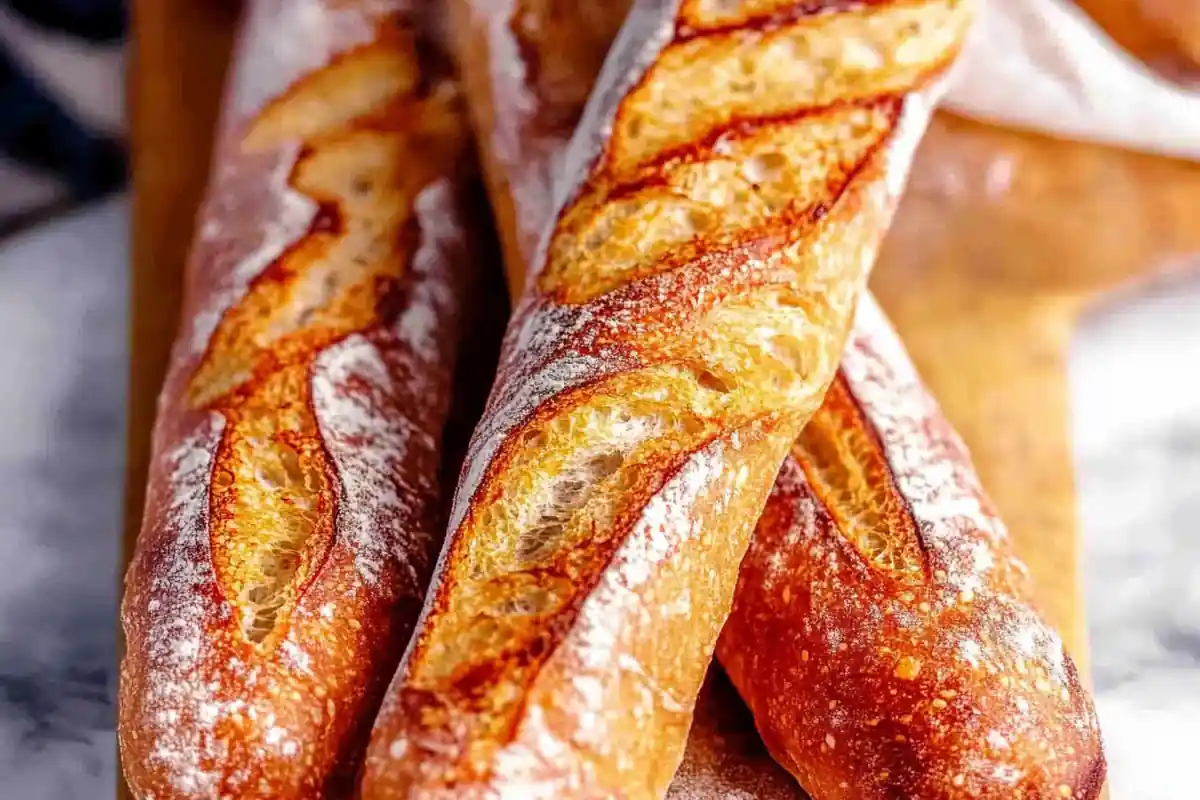Baguettes that have a crunchy outer crust are a true marvel of baking. The symphony of textures, the satisfying snap, and the tender interior all contribute to a delightful experience. This article will explore the secrets to achieving this incredible result. We’ll delve into the essential steps and techniques. These techniques create that coveted crust.
The Essential Science of a Crunchy Crust
Creating baguettes with a crunchy outer crust involves a few key factors. First, the right flour is crucial. Second, the proper hydration level in the dough is vital. Finally, appropriate baking techniques are extremely important. Flour with a high protein content helps develop gluten. Gluten contributes to a good structure. Therefore, this is important for a crusty baguette.
Flour Choice and its Impact
High-protein bread flour is usually the preferred choice for baguettes. It allows for the formation of strong gluten networks. This network gives the baguette its shape and texture. It also provides the necessary structure for a crisp crust. Lower protein flours might result in a softer, less satisfying crust, similar to what you might experience with some cottage cheese flatbread recipe. The kind of flour matters for great results.
Hydration’s Role in Crust Development
Hydration refers to the water content in the dough. A higher hydration dough tends to produce a more open crumb. It also contributes to a thinner and crisper crust. The steam created during baking is very important. Steam prevents the crust from setting too early. This allows for more expansion and better crispness. Therefore, hydration should not be overlooked.
The Importance of Baking Techniques
Baking technique is everything when it comes to a crunchy crust. High initial oven temperature is important. Using a preheated baking stone or steel can enhance the crust, similar to how a hot surface helps when making a great steak and potatoes recipe. Creating steam in the oven during the first part of baking is critical. It helps the crust develop fully. Finally, allowing the baguettes to cool completely on a wire rack is key. This prevents a soggy bottom.
Image Placeholder: alt text: Baguettes with a crunchy outer crust, straight out of the oven.
Achieving the Perfect Crunchy Crust
Achieving that amazing crunch takes attention to detail. It requires a combination of precise techniques. The process begins with dough preparation. Then, it transitions to shaping. Finally, it finishes with the baking itself. Each step contributes to the end result. It’s a journey worth taking for the final product.
Dough Preparation for Crunchiness
The initial dough mixing is extremely important. Proper mixing ensures the gluten develops thoroughly. This produces a strong and elastic dough. This strength is what allows it to have the needed structure. A longer fermentation time allows for better flavor development. It can also influence the texture of the crust. Furthermore, gentle handling of the dough is also important.
Shaping the Baguettes
The way you shape the baguettes also affects the crust. A properly shaped baguette has a smooth surface. This even surface leads to a uniform crust. Avoid rough handling which can deflate the dough. This also compromises the airiness of the crumb. A gentle and quick approach is essential. Maintain the structure you worked so hard to get.
Baking Techniques for a Crisp Exterior
Proper baking technique will turn a good loaf into a great one. Start with a hot oven. Preheating your oven to at least 450°F (232°C) is ideal. Use a baking stone or steel to transfer heat evenly. Introducing steam during the initial baking phase is crucial. You can do this by spraying the oven with water. Or by using a pan of water placed at the bottom of the oven.
Image Placeholder: alt text: Dough being shaped into baguettes on a floured surface.
The Role of Steam in Crust Formation
Steam plays a critical part in achieving a crunchy crust. It helps in several ways that contribute to the final result. Without enough steam, the crust might become thick and hard, but not crunchy. It affects the way that the starches gelatinize on the surface of the loaf, similar to how the base of a strawberry poke cake recipe can become moist. It’s a vital part of the baking process.
How Steam Creates the Crunch
Steam keeps the crust moist for a longer time in the early baking phase. This allows the loaf to expand further. It then helps starches on the surface to properly gelatinize. As the water evaporates, the crust becomes brittle. This brittle crust is what produces the wonderful crunch. Steam is a key to success.
Methods for Generating Steam at Home
There are several ways to create steam at home. You can use a spray bottle to mist the inside of your oven. Another option is to place a baking pan of hot water on the bottom rack of your oven. You can also use lava rocks. They hold a great deal of heat. Add hot water to create a burst of steam. Choose the method that works best for you.
Avoiding Common Steam-Related Pitfalls
It is possible to over-steam your oven. This can lead to a soggy crust. Too little steam can result in a hard, thick crust that is not crisp. Finding the right balance is necessary. Therefore, the timing is critical. Learn how your oven operates. Adjust your techniques accordingly.
Image Placeholder: alt text: Close up of a baguette being scored with a knife.
Troubleshooting Common Issues
Baking can be unpredictable at times. However, with some knowledge you can identify and fix common issues. This can range from a pale crust to a tough interior. We will look at common problems and discuss solutions. We’ll get you baking better baguettes every time.
Pale Crust and How to Fix It
A pale crust indicates that the oven temperature might be too low. It could also mean that the baguettes were not baked long enough. A lack of steam might be another reason for this problem. To solve it, check the temperature of your oven using an oven thermometer. Then, you can increase baking time as needed. Also make sure to provide sufficient steam early in the baking phase.
A Thick Crust That Isn’t Crunchy
A thick, hard crust usually indicates insufficient steam. It might also mean the oven is too dry. A lower hydration dough can also cause this. Ensure that your dough has enough water. Also, double check that you use steam effectively during the initial phase of baking. This should create a better, crispier crust.
A Dense, Doughy Interior
A dense interior may be caused by several things. The dough may not have been fermented long enough. The gluten may have been overworked. The dough may also have not been properly proofed. Allow enough time for fermentation. Be gentle when mixing the dough. You will also want to proof correctly before baking. Therefore, pay close attention during each step.
Image Placeholder: alt text: A close-up shot of a broken baguette revealing the inner crumb.
Baguettes that have a Crunchy Outer Crust: Final Thoughts
Achieving baguettes that have a crunchy outer crust is very rewarding. It does require some attention to detail. However, the effort is well worth it. With practice, you can consistently bake amazing baguettes. This process combines art and science. You will be a master baker soon.
The Art of Baking
Baking is a combination of technique and intuition. Experience plays a huge role in improvement. Do not be afraid to experiment. Keep notes of your process. This will help you discover what works best. Therefore, each time you bake will be an opportunity to learn more.
Sharing Your Baking Success
The joy of baking is often increased when shared. There is nothing like sharing your freshly baked bread with loved ones. These loaves, with their wonderfully crisp crusts, are sure to be a hit. Your friends will enjoy them. It can be a true culinary experience when they come out perfectly.
Continued Learning and Development
The journey of baking is ongoing. There’s always something new to learn. Be open to trying new things. Always look for improvement. With each loaf you bake, you gain more experience. Therefore, you’ll be on a continued path to baking perfection.
FAQ
How do we get the crispy crust on a baguette?
The key to getting a crispy crust on a baguette involves several important steps. First, use high-protein bread flour. This will help with structure and texture. Second, hydrate the dough properly. It will produce a more open crumb and a thinner crust. Lastly, using enough steam in the oven during the initial baking process is vital. Ensure the oven is hot enough when baking.
What are the three types of baguettes?
While there aren’t specifically three universally agreed-upon “types” of baguettes, some common variations are the classic baguette, the ficelle, and the baguette viennoise. The classic baguette is the most common. The ficelle is thinner, and the viennoise uses added ingredients like milk or butter. Each has its unique characteristics.
What is crusty French bread called?
“Crusty French bread” is most often referred to as a “baguette” or “pain français”. While “French bread” is sometimes used for similar types of loaves, the term baguette specifically denotes the long, thin shape and the desired crusty texture. Therefore, “baguette” is usually the best term.
What is the difference between a baguette and a ficelle?
The main difference between a baguette and a ficelle is their size. A baguette is a longer, thicker loaf, whereas a ficelle is a very thin version. Ficelles are often around half the width of a standard baguette. This difference in size influences their texture and baking time. Ficcelle will bake much faster due to their size.

